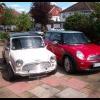if this is classed as tech, sorry , feel free to move it
but is there any where you can find out how a cooper should be IE
was there a cooper every year or only certain years, are there only certain engines sizes, wheels, wheels size, body colour, engine spec, exhaust type
im just thinking if you wanted to make a cooper look alike down to the last detail, i know its probably cheaper to just go and buy one but im new to the scene and i just like to know these things, cause you see coopers on ebay n stuff all the time for 4 n 5 grand but they all look different, big arches, wee arches, big exhaust, wee pea shooter exhaust, any one ahed any light ?
Cooper
Started by
weebara
, Jun 04 2011 10:33 PM
4 replies to this topic
#1

Posted 04 June 2011 - 10:33 PM
#2
 Guest_minidizzy_*
Guest_minidizzy_*
Posted 05 June 2011 - 12:01 AM
"Original Mini Cooper and Cooper S" by John Parnell is the definitive guide.
www.amazon.co.uk/Original-Mini-Cooper-Restorers-Guide/dp/1906133190/ref=sr_1_1?s=books&ie=UTF8&qid=1307228828&sr=1-1
But it was written before the end of production and does not cover the late MPi Coopers and is mainly about the early Coopers.
Coopers were built from 1961 to 1971 and then from 1990 to 2000 with a huge gap between.
The early Coopers are rare and very valuable and have varying engine sizes (970, 997, 998, 1071, 1275). All had 10" wheels.
The late (Rover) Coopers are fairly similar to each other. All had 1275cc engines although there are a few Cooper converted 998cc cars immediately before that.
The first of the Rover Coopers was the very rare RSP in 1990, followed quickly by the Mainstream. Both had carburettors. Very soon after came the Spi (single point injection) and then in late 1996 the MPi (multiple or twin point injection). The standard wheel size was 12".
The wide arches were part of the "sports pack" option. There was no difference in the engine and the bigger (13") and wider wheels actually reduced the performance very marginally. The large bore chrome tailpipe finisher was part of the sports pack option. Sports pack Rover Coopers are worth more but I do not know why and I would not have one myself.
Higher performance could be achieved on Rover Coopers with a John Cooper conversion, which is still available for the MPi but there are alternatives on the market, for example Palmer Brothers.
There are no factory produced standard Cooper Ss from the 90s. Any with an S badge is a John Cooper conversion or a limited edition.
Colours are a bit more complicated to deal with as they varied over time. Flame Red, Tahiti Blue, British Racing Green and Almond Green are classic Cooper colours but there were many others. Roofs were always a different colour for Coopers (except for the Mk III), always white (or silver) for the 90s but sometimes black for the 60s.
www.amazon.co.uk/Original-Mini-Cooper-Restorers-Guide/dp/1906133190/ref=sr_1_1?s=books&ie=UTF8&qid=1307228828&sr=1-1
But it was written before the end of production and does not cover the late MPi Coopers and is mainly about the early Coopers.
Coopers were built from 1961 to 1971 and then from 1990 to 2000 with a huge gap between.
The early Coopers are rare and very valuable and have varying engine sizes (970, 997, 998, 1071, 1275). All had 10" wheels.
The late (Rover) Coopers are fairly similar to each other. All had 1275cc engines although there are a few Cooper converted 998cc cars immediately before that.
The first of the Rover Coopers was the very rare RSP in 1990, followed quickly by the Mainstream. Both had carburettors. Very soon after came the Spi (single point injection) and then in late 1996 the MPi (multiple or twin point injection). The standard wheel size was 12".
The wide arches were part of the "sports pack" option. There was no difference in the engine and the bigger (13") and wider wheels actually reduced the performance very marginally. The large bore chrome tailpipe finisher was part of the sports pack option. Sports pack Rover Coopers are worth more but I do not know why and I would not have one myself.
Higher performance could be achieved on Rover Coopers with a John Cooper conversion, which is still available for the MPi but there are alternatives on the market, for example Palmer Brothers.
There are no factory produced standard Cooper Ss from the 90s. Any with an S badge is a John Cooper conversion or a limited edition.
Colours are a bit more complicated to deal with as they varied over time. Flame Red, Tahiti Blue, British Racing Green and Almond Green are classic Cooper colours but there were many others. Roofs were always a different colour for Coopers (except for the Mk III), always white (or silver) for the 90s but sometimes black for the 60s.
#3

Posted 05 June 2011 - 02:12 PM
wow, great responce, cheers
very helpfull, and ill check out the book
thanks alot
michael
very helpfull, and ill check out the book
thanks alot
michael
#4

Posted 05 June 2011 - 02:30 PM
Joining the Mini Cooper Register is a good place to start, here is a sample "low-res" pdf copy of the 'CooperWorld' monthly magazine:
http://www.minicoope.../sample_mag.pdf
http://www.minicooper.org/index.htm
http://www.minicoope.../sample_mag.pdf
http://www.minicooper.org/index.htm
Edited by mab01uk, 05 June 2011 - 02:32 PM.
#5

Posted 05 June 2011 - 07:55 PM
And don't forget the Italian-built Innocenti Mini-Cooper which is a highly-regarded genuine Mini-Cooper as it was produced with the name licenced by John Cooper. Particularly sought-after are the 1972 - 75 Innocenti Mini-Cooper 1300 Exports. These have a 1275 GT engine with twin 1.25" SU's, original U.K.Cooper 'S' camshaft, 11-stud head, 7.5" disc brakes and 10" wheels at 4.5" width. All are left-hand-drive and have what is arguably the best interior and dashboard design of any Mini.
1 user(s) are reading this topic
0 members, 1 guests, 0 anonymous users















